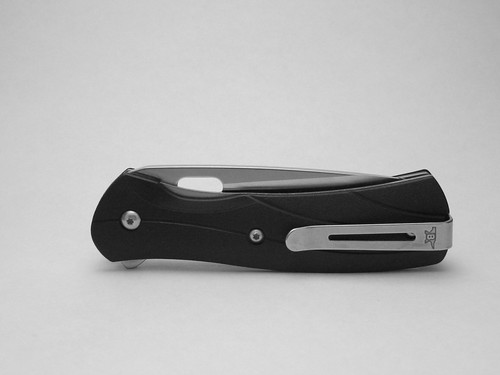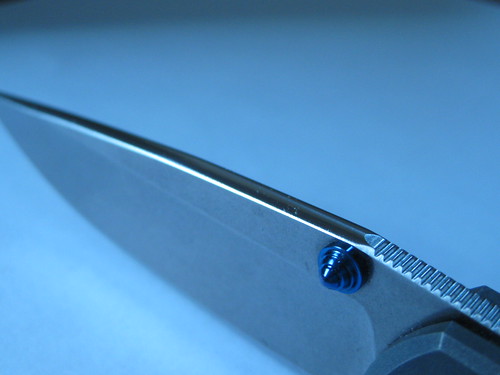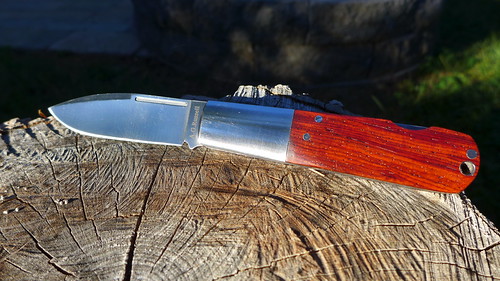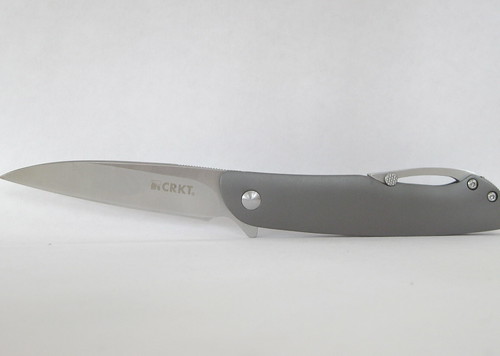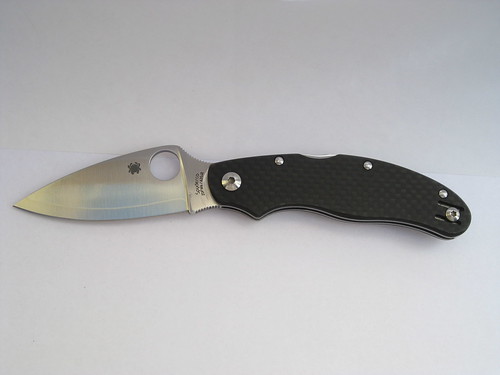Top Ten Folding Knife Designers
People love lists. They really like top tens. People also like controversy, so I thought I'd post a list on the best folding knife designers. Before I get to the actual list, I need to spell out the criteria and then note a few designs or people that can't be included for various reasons (that I just made up but seem pretty good to me).
First, by knife designer, I don't necessarily mean knife maker. Many great knife makers work in the traditional style of folding knives but they do little to no design because they are making a specific pattern of knife. They are knife makers but not knife designers. Additionally, a knife designer could be someone that works in-house at a production company and sketches stuff out in CAD but never actually grinds a piece of steel. Second, I am excluding from consideration two groups. First, I am excluding people that make folders but are primarily famous for other things. Bob Dozier makes some wicked folders, but his acclaim originated from and is largely because of his fixed blades. This is obviously a judgment call thing, but I will try to be a consistent as possible. Second, I am not really going to consider folks from ages past. This is really a list of the last 20-30 years. Going back beyond that is very difficult to do. I'd like to put the guy that invented the Barlow on this list but that person has been lost in the mists of time (though no fewer than four people claim to be that guy). Blackie Collins could be on here, but because of the lack of widespread coverage of knives at the time it is hard to figure out if he did something first or if he did something that publicized first. Now, with Blade, the internet, and YouTube, it is pretty easy to source who did what first (though not always, see below: Kit Carson).
Here are the four criteria I am using to define the success of a knife designer: 1) market impact; 2) longevity and/or high output; 3) aesthetics; and 4) innovation. It is rare, even on this list to find someone that does all four of these things very well. Some of these have pretty objective criteria, such as market impact, which comes down to two things: 1) how well have their knives sold? and 2) how influential were their designs on the market. That is easy. Others, like design aesthetic are much harder to speak about in objective terms. As a result, this list is a list of MY favorites and while I am more than willing to defend and argue about my list, I am sure your list is different.
There are a few people that I want to include but can't for various reasons. Here they are in summary. If there were one member of the Buck family that designed all of their knives, they'd be on the list, but there have been at least three generations of Bucks who have all contributed quite a bit. Untangling who did what and attributing a design to the father or the son or the grandson is too difficult for an outsider to do, so they are all off the list. The Buck 110 is arguably the most important folder ever and it seems odd to leave its designer off the list, but figuring out exactly who did what is pretty hard. It seems like it was designed by or at least at the behest of a committee. A lot of really famous knife makers just tweaked older designs. Tony Bose makes some of the very best knives produced by humans, but his shtick is to resurrect old patterns. So he is off the list as he is more a knife maker than a designer. Ron Lake who invented the tail lock and the interframe is also off the list because, again, he is working within a tradition. Additionally his innovations are so labor intensive they have not really trickled down to the masses and had a market impact. Blackie Collins, mentioned above, is also off the list. Al Mar could be on this list, but I am not sure of the scope of his influence. So many people were doing similar things around the same time that like Blackie Collins teasing out who did what when is difficult for me to do.
There are very few knife makers in the world that have as distinctive aesthetic as Gus Cecchini. Gus's knives, produced in Brazil under the GTC label, are angular and unusual. They use top notch materials, have beautiful (usually hand rubbed) finishes, and most open with a flipper. But he's not just a maker of beautiful things, he also pours in a ton of innovations. His hidden pocket clip is both gorgeous and ingenious and his bearing based pivot receives rave reviews from customers. His market impact, at this point is very limited. His knives are very expensive, from him they start around two grand, and on the secondary market they are 50% to 200% more, but he does have a Boker production version of his Federal model (though really what custom maker doesn't have a Boker version of their knife?). This ranking is really about his aesthetic vision and innovation. He'll be on this list sooner rather than later.
10. Ernie Emerson
If measured solely by the loyalty of one's customers, Emerson should be on the top of the list. Emerson buyers rank right up there with Special Forces guys in terms of their intensity and loyalty (note the large overlap between Emerson buyers and Special Forces guys). His innovation, the Wave, is very clever, solving a problem many knife designers couldn't. It has limited utility outside of a tactical setting and is done better by others (the Wave on the Endura is sooooo good), but that's not all Ernie did. Uber collector Justin Laffer suggests that the A-100 is one of the perfect knife designs and I agree with him. Ernie's understanding of the market, knife construction, and his laser beam focus on products has produced a line of hard use folders that really are used hard. His customs are equally tough, but just as beautiful. Not the best at one thing, other than building brand loyalty, Emerson belongs on this list for his all-around excellence.
9. Tom Mayo
With clean, almost antiseptic lines and exotic materials Tom Mayo's customs are chase items for collectors the world over.
Image courtesy of Aaron Shapiro at Practically Everyday.
His production knives, produced by Buck, are also sought after by collectors. His market impact can be seen in almost 1/3 of the Buck line. The high end Paradigm and the lower end Vantage and Vantage Force lines all borrow heavily from Mayo's designs.
His oval thumb hole and simple blade shape can't be missed. On the innovation front, his TnT and Covert customs introduced the world to exotic materials--Stellite and Talonite as steel substitutes (the TnT stands for Talonite and Titanium). Clean simple framelocks seem to have infested the custom world and they all owe a bit of their design DNA to Mayo.
Image courtesy of Aaron Shapiro at Practically Everyday.
His production knives, produced by Buck, are also sought after by collectors. His market impact can be seen in almost 1/3 of the Buck line. The high end Paradigm and the lower end Vantage and Vantage Force lines all borrow heavily from Mayo's designs.
His oval thumb hole and simple blade shape can't be missed. On the innovation front, his TnT and Covert customs introduced the world to exotic materials--Stellite and Talonite as steel substitutes (the TnT stands for Talonite and Titanium). Clean simple framelocks seem to have infested the custom world and they all owe a bit of their design DNA to Mayo.
8. Jens Anso
No one since Sal Glesser has more radically rethought the folding knife than Jens Anso. His customs are wicked and/or alien looking designs with odd blade shapes, topographical looking handle scales, and asymmetric grinds (though not in production knives).
But his market impact is probably equal to his innovation. He has worked with three major production companies, a little with Spyderco and a lot with Fox Cutlery and Boker. Boker seems to spin off a new Anso designed folder once a month. Given that he has been actively making knives for around a decade, this much innovation and market presence bodes well for the future. His aesthetic is a take it or leave it kind of thing but quite a few people have taken it, especially his ultra grippy "Anso" pattern handle scales.
But his market impact is probably equal to his innovation. He has worked with three major production companies, a little with Spyderco and a lot with Fox Cutlery and Boker. Boker seems to spin off a new Anso designed folder once a month. Given that he has been actively making knives for around a decade, this much innovation and market presence bodes well for the future. His aesthetic is a take it or leave it kind of thing but quite a few people have taken it, especially his ultra grippy "Anso" pattern handle scales.
7. Bob Terzuola
Bob Terzuola didn't invent a locking mechanism or a deployment method, he invented a type of knife--the modern tactical folder--that has taken the knife world by storm.
Image courtesy of Aaron Shapiro at Practically Everyday.
Not so much a mechanical thing, his influence comes from developing a certain style and build (overbuilt) of knife. Personally, I don't like these big "tactical" blades, but lots and lots of people do. The market would not be the same without Terzuola and his long time custom business is still booming.
Image courtesy of Aaron Shapiro at Practically Everyday.
Not so much a mechanical thing, his influence comes from developing a certain style and build (overbuilt) of knife. Personally, I don't like these big "tactical" blades, but lots and lots of people do. The market would not be the same without Terzuola and his long time custom business is still booming.
6. Kit Carson
The first of the "Big Three" Innovators, and perhaps the most underrated. Kit Carson invented the flipper. Unless you have been following the knife industry for a long time, or carefully reading the Spyderco product literature (which goes out of its way to correctly attribute inventions), you might not have known that. He also has been making gorgeous and minimalist custom knives for decades. The Flipper is probably the biggest innovation in folding knives since the frame lock and I would argue that the flipper is even more important. It solves a problem--opening a knife--in a fundamentally different and vastly simpler way. Going back to what Donald Norman wrote in the Design of Everyday Things, the flipper has a perfect conceptual model. Looking at it tells you instantly and without words, how it works. You see it and your mind, naturally, understands it. I like thumb holes a lot, but the design geek in me wants to say the flipper is the best way to open a knife. The market seems to agree, as flippers are everywhere, from high end multi-kilobuck customs, like Aaron's Burch Tangent, to cheapo knives like the excellent RJ Martin designed Chill. The flipper rocks, Carson invented it, and no one seems to remember. Bad on us.
5. Michael Walker
The liner lock is the necessary first step in terms of design for almost all of the major knife innovations we enjoy today. Without it, the flipper would be impossible, the frame lock inconceivable, and the bearing pivot unnecessary. Michael Walker invented the modern liner lock, with its elegant detent, and for that, he deserves to be on this list. But his greatness is more than just that. His customs have been sought after for decades, sitting as a high water mark for the art of knife design and they command prices only Ron Lake can exceed. He is not just a custom knife savant though, his production designs, specifically the Spyderco Michael Walker, command a huge premium on the secondary market. His output is not that great, but like JD Salinger, if you make something truly great, you don't need to make a lot of things to be noteworthy.
4. Chris Reeve
The last and probably the most important of the "inventor" designers. Chris Reeve's framelock is incredibly influential and innovative.
It has spread like a virus throughout the industry. But if I were a financial analyst I would tell you that is only his SECOND greatest invention. His real innovation is creating a market space where he can readily sell hundreds of high end production knives that START at $350. The beauty of what Chris Reeve did is similar to what Starbucks did--he was able to convince consumers that there is value in paying 300% more for something pretty basic. But unlike Starbucks, which makes dreadfully overroasted and overflavored coffee devoid of any subtlety, Chris Reeve used virtually unmatched quality and consistency to convince consumers. Something of a prickly pear, Mr. Reeves annual acceptance speech at Blade for Best Manufacturing quality has become something of a tradition in seeing how pompous someone can be, but when you make knives this good and sell them for as much as he does, he can get away it with. There is a point at which confidence seems like arrogance. Holding a Sebenza in your hand will persuade you it is more the former than the latter. He makes great knives.
It has spread like a virus throughout the industry. But if I were a financial analyst I would tell you that is only his SECOND greatest invention. His real innovation is creating a market space where he can readily sell hundreds of high end production knives that START at $350. The beauty of what Chris Reeve did is similar to what Starbucks did--he was able to convince consumers that there is value in paying 300% more for something pretty basic. But unlike Starbucks, which makes dreadfully overroasted and overflavored coffee devoid of any subtlety, Chris Reeve used virtually unmatched quality and consistency to convince consumers. Something of a prickly pear, Mr. Reeves annual acceptance speech at Blade for Best Manufacturing quality has become something of a tradition in seeing how pompous someone can be, but when you make knives this good and sell them for as much as he does, he can get away it with. There is a point at which confidence seems like arrogance. Holding a Sebenza in your hand will persuade you it is more the former than the latter. He makes great knives.
3. AG Russell
In Outlier, Malcolm Gladwell talks about a Chinese proverb about longevity and hard work. Paraphrasing the proverb it is something like: "A man that wakes before dawn and works through the day for 300 days a year for 30 years will always be successful." That seems to apply well to AG Russell, except he hit his 30th year 20 years ago. In the last calendar year, the first of his ninth decade, saw Russell release at least four new knife designs--the Acies2, the Ti Button Lock, the Orca, and the Skorpion. He also updated and tricked out his Barlow, released a lock back designed by Bob Loveless, and released a nuke-tough fixed blade with its own proprietary steel.
I hope to God I am that productive at his age. He has been around for so long and made so many excellent designs that it is hard to not just say he is the best based on sheer volume alone. But the quality of his stuff, even the stuff from his Chinese OEMs is really outstanding. Additionally, because of his ability to sell direct to consumers, his style, especially as seen in his handle shapes on things like his One Hand knife and the Skorpion, is unfiltered by corporate concerns. The only knock is that Russell seems to be something of a synthesizer and not QUITE as innovative as the other two men higher on this list. Its a very small difference, as his innovation is still top notch (the One Hand Knife has its own ambidextrous lock design that is brilliant it is utility and simplicity), but not quite at the same level as #2 or #1.
I hope to God I am that productive at his age. He has been around for so long and made so many excellent designs that it is hard to not just say he is the best based on sheer volume alone. But the quality of his stuff, even the stuff from his Chinese OEMs is really outstanding. Additionally, because of his ability to sell direct to consumers, his style, especially as seen in his handle shapes on things like his One Hand knife and the Skorpion, is unfiltered by corporate concerns. The only knock is that Russell seems to be something of a synthesizer and not QUITE as innovative as the other two men higher on this list. Its a very small difference, as his innovation is still top notch (the One Hand Knife has its own ambidextrous lock design that is brilliant it is utility and simplicity), but not quite at the same level as #2 or #1.
2. Ken Onion
Looking at Ken Onion's list of inventions makes him the Thomas Edison of the folding knife. The Big Three Innovators all did one or two things that were truly remarkable, but Onion did a bunch more. The Speedsafe assist mechanism, which I personally don't like because I dislike all assisted openers, is unquestionably an industry altering design. Its release in the mid-90s changed the trajectory of Kershaw and the entire industry. One could argue that that single innovation launched the Golden Era of Gear we are still basking in tp this day. His aesthetic is very distinctive with its curvy organic feel. I don't really like it, but he has shown with knives like the Swindle that he is not a one trick pony.
His market impact goes beyond the inventions though. He is THE big name free agent designer in the production world. His switch from Kershaw to CRKT a few years ago signaled a sea change in the production world and a shift of fortunes for CRKT. Where Onion goes, success, innovation and profits follow. Did you notice how many times he went to the award dias at BLADE? That's my point.
His market impact goes beyond the inventions though. He is THE big name free agent designer in the production world. His switch from Kershaw to CRKT a few years ago signaled a sea change in the production world and a shift of fortunes for CRKT. Where Onion goes, success, innovation and profits follow. Did you notice how many times he went to the award dias at BLADE? That's my point.
1. Sal Glesser
Among baseball historians there is a debate about the mark of a good pitcher. Is it the pitcher that had the best peak or the pitcher that was good for the longest time? In the pre-Pedro, Roger, and Maddux era, the debate came down to three pitchers: Lefty Grove, Cy Young, and Walter Johnson. Grove, on a per inning basis, was better than anyone in baseball history with more than a ten year career. Cy Young on the other hand was good for a long time. Bill James said in his book ranking players that Cy Young pre-1900 was a Hall of Famer and Cy Young post-1900 was a Hall of Famer. He was good for so long that half his career is better than all but 1% of all pitchers ever. But he never dominated like Grove did. But then there is Johnson. He pitched for more than 20 years and racked up the second highest wins total ever (not that wins are the end all, be all). He was 90% of Grove and 80% of Young. His combination of concetrated greatness and longevity meant, at least for Bill James (and many others) that Johnson was the greatest pitcher of all time. The debate is more interesting now because we have the Pedro/Roger/Maddux trio to look at, but still the point carries over well here.
Sal Glesser is the Walter Johnson of knife designers. His innovations are staggering--the thumb hole opener, the pocket clip, and a myriad of lock designs including of my favorite lock (the Compression Lock). His market impact, as head of Spyderco, is as great as anyone else. His aesthetic is unmistakeable.
In fact, its striking character is lost only because he designed so many blades. If he had a smaller output, his vision of the folding knife would stand out even more. And that is the real difference maker here. Sal has designed more than 100 knives over 20 some years. Spyderco Source has his as the designer on about 115 knives and there are a few new ones they are missing.
In fact, its striking character is lost only because he designed so many blades. If he had a smaller output, his vision of the folding knife would stand out even more. And that is the real difference maker here. Sal has designed more than 100 knives over 20 some years. Spyderco Source has his as the designer on about 115 knives and there are a few new ones they are missing.
Sal is either the #1 or #2 person is each of the four categories I am looking at and even the #2 ranks are arguable. There can be no doubt, Sal Glesser is the greatest folding knife designer of the last 30 years.
I am sure people will disagree. I feel a little weird placing Ken Onion so high, but his dominance of the Blade categories and the sales of his blades make him hard to ignore. I also feel weird leaving pure custom makers off the list, guys like Jeremy Marsh. Their market impact is limited to homages and a very few customs made or sold. Hinderer was a consideration as well, but I couldn't figure out who to boot out to add him. Similarly I was thinking that RJ Martin should be on the list. Not only does he make great customs, but production companies LOVE working with him. He basically delivers a complete CAD design making the production process super simple. I think there is really no dispute with the #1 choice and I think all ten guys chosen are worthy members of this list, but beyond the #1 rank I am not sure of the order. I wrote and rewrote this a couple of times and I am comfortable with the list now.
I am sure people will disagree. I feel a little weird placing Ken Onion so high, but his dominance of the Blade categories and the sales of his blades make him hard to ignore. I also feel weird leaving pure custom makers off the list, guys like Jeremy Marsh. Their market impact is limited to homages and a very few customs made or sold. Hinderer was a consideration as well, but I couldn't figure out who to boot out to add him. Similarly I was thinking that RJ Martin should be on the list. Not only does he make great customs, but production companies LOVE working with him. He basically delivers a complete CAD design making the production process super simple. I think there is really no dispute with the #1 choice and I think all ten guys chosen are worthy members of this list, but beyond the #1 rank I am not sure of the order. I wrote and rewrote this a couple of times and I am comfortable with the list now.


